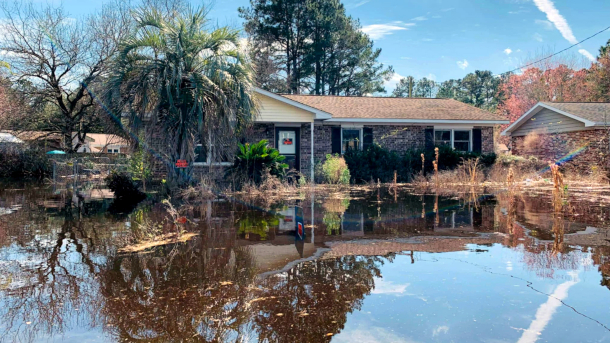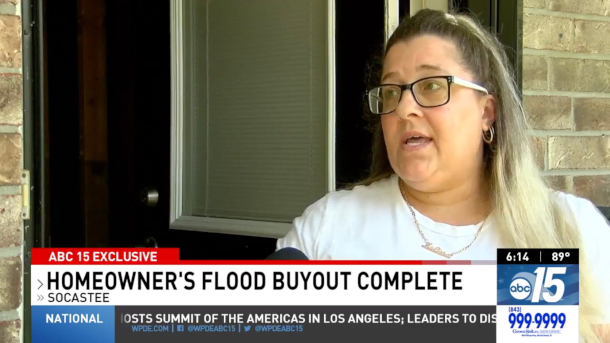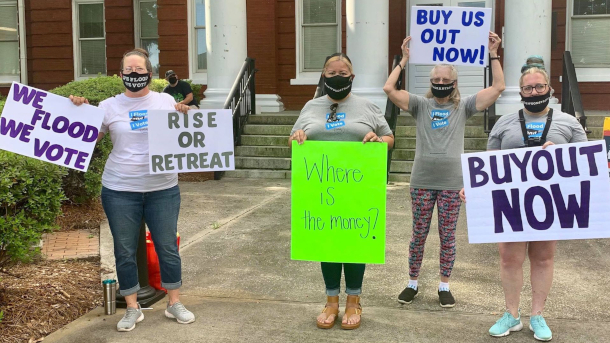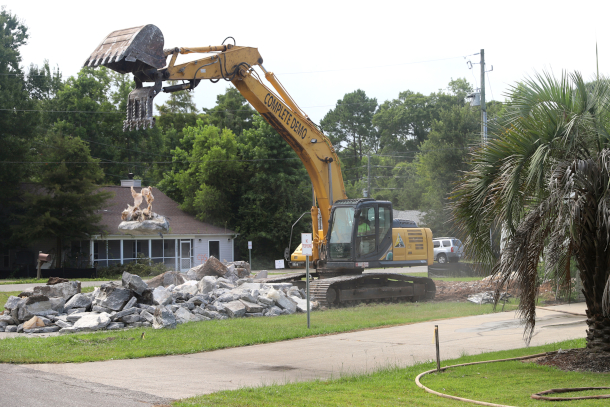Flood Buyout Delays
Air Date: Week of September 13, 2024

Melissa Krupa’s Socastee home after a flood in February 2021, weeks before the first grants to start a buyout program were approved. (Photo: Courtesy of Melissa Krupa)
South Carolina is offering to help homeowners move away from areas plagued by flooding, but at one flagship buyout, only one in ten eligible residents chose to participate. Freelance journalist Daniel Shailer reported on this for Inside Climate News and explains to Living on Earth’s Jenni Doering why delays and predatory real estate practices are getting in the way of moving people out of harms’ way.
Transcript
O’NEILL: Coastal and low-lying areas across the US are experiencing increased flooding linked to the climate crisis, leaving homeowners with costly water damage. The state of South Carolina is facing the reality that in some areas managed retreat may be the only option. A 2023 resilience report found that the state may need to buy out and tear down roughly 700,000 flood-prone homes. South Carolina is one of the few states with a dedicated climate resiliency office and a plan for adapting to climate change. In some coastal areas the state is offering to help homeowners move by buying out homes from residents living in floodplains and turning the land into green space, better adapted to absorbing and retaining water. Daniel Shailer is a freelance climate journalist who reported on this buyout program as part of a climate adaptation series for our partner InsideClimate News. He joined Living on Earth’s Jenni Doering to discuss how this is playing out in the South Carolina town of Socastee.
DOERING: So why is South Carolina so vulnerable to flooding these days?
SHAILER: It's a good question and I think we think of sea level rise as a kind of homogenous, equal threat around the world, but it's a much more localized thing. And because of the way that ocean currents are changing along the Gulf states on the East Coast, the sea level is actually rising locally much faster and at an accelerated rate. So South Carolina is kind of on the front line, along with Florida, North Carolina of that change, but at the same time, South Carolina, for other reasons is one of the fastest growing states in the country. Coastal property is on the up. Second homes people moving to the coast. So those two things in conjunction, more and more people moving into a coastal area that is more and more under threat from sea level rise. That's one of the reasons that South Carolina and coastal South Carolina is at climate risk.
DOERING: And when you add to that, these storms that can bring intense downpours, that's a whole other flooding issue as well.
SHAILER: Yeah, as you probably be aware. Some scientists like to call them kind of rain bursts or rain bombs, but warmer air, for listeners that aren't familiar, warmer air holds more moisture. And so it's not that there's more water in the actual water cycle, but when it does rain, it rains in kind of biblical bursts of huge amounts of rain. And so that works with sea level rise, because it's not just like waves lapping over the top of the coast, but as sea levels rise, the water underneath the Earth, the groundwater table, also rises. That means when a rain burst or a rain bomb arrives, there's less kind of dry, unsaturated earth above the ground level to absorb that water. More water ends up, kind of sloshing around on top flooding houses, interrupting people's lives.
DOERING: And meanwhile, you say people are moving into this region, even as the state is acknowledging these risks and actually trying to help people move out. So tell us about this home buyout program that South Carolina is embarking on that caters to some of these climate vulnerable communities. How does this program work?
SHAILER: Yeah, it's part of, I suppose, a more broad changing of coastal resiliency strategy. The prevailing wisdom for a while, I think, has been the coast to getting more vulnerable. Let's hunker down. And hunkering down in a coastal resiliency context looks like sea walls, flood gates, building houses on stilts, basically like not budging but getting prepared in some kind of way. Managed retreat strategy or policy as an idea, is the idea that instead of hunkering down, we will move back away from the coasts. And the most equitable way to do that, when you know some people can't afford to just up and move, is to have a kind of buyout, where the state or federal agency comes along and offers homeowners, typically some kind of amount pegged to the value of their home, to buy their home from them so that they can relocate somewhere more in land. So it is true that South Carolina is, I think it fair to say, ahead of the curve compared to other states. They know how many houses they think will need to retreat back. This is how much it might cost. And they even have what they call a kind of matrix for looking at not just climate risk in terms of low lying ground, sea level rise, rain, but also kind of socio economic factors about which areas might need more help than others. So Socastee was one of those places.

Melissa Krupa spent six years attempting to secure a buyout and the demolition of her Socastee home. (Photo: Screenshot, WPDE video)
DOERING: So how much money is the state able to offer some of these homeowners when they are trying to get them to move out?
SHAILER: It's a little bit of a complex question to answer. Managed retreat is a beautifully simple idea in principle, offer people some money. They just move inland, somewhere safer. Everyone's happy that land becomes typically a green space which absorbs floodwater and then becomes a kind of public asset for people to use, playgrounds, that kind of thing. But in practice, it is almost always a little bit more complicated, if not messy. So the funding question depends where the funding is coming from. In South Carolina and in Socastee, the upper cap was around a quarter of a million dollars, with a couple of things that could make it higher or lower but that was basically, that was the cap, a quarter of a million dollars. Which for some people, was more than enough, for some people, was about right, and some people that have, you know, the really kind of decked out waterfront houses doesn't come near.
DOERING: Yeah, I mean, the government is offering you money to move, but sometimes the price isn't right. So I understand you talked to Melissa Krupa. She participated in this buyout program, she lived in this community Socastee, South Carolina, that you wrote about. Tell us about Melissa.
SHAILER: Melissa is a real force of nature, I think it's fair to say. When I first spoke to her, it was kind of at the tail end of a six year battle for her. First to get a buyout and then to get the state to actually demolish her home like they promised. And I've actually got a clip from Melissa talking about what she went through. Let's take a listen.
KRUPA: 2016 my house flooded with three and a half feet of water in my house, I did start to remodel and rebuild, and then in 2018 I lost my house again to flooding five and a half feet of water. And at that time I realized I had to do something, I couldn't keep rebuilding. I didn't want to live in flood waters, and I knew I had to do something for me and my community because we kept losing our house. Some people in my neighborhood that are closer to the water lost their house like 10 times. So I knew I had to do something and that's when I decided to start speaking up.
DOERING: So Melissa has this conviction, this strong voice, what does she do to try and help her community and help herself as a homeowner?
SHAILER: Yeah. So I suppose the first thing that Melissa does is start casting around among her neighbors, starts looking online and through that she comes across a woman called Harriet Festing. Who runs a group at the time, it was a kind of coalition of maybe 40 or so frontline environmental groups called Anthropocene Alliance that is now well over 300 into 400 groups. But at the time, it was a kind of small organization, and it was Harriet trying to connect groups that were living with climate change already this was back in 2018 with the resources to start speaking up for themselves. So that was the beginning of a six year fight for Melissa and her neighbors. It was only, gosh, only a month ago that her home was actually demolished. So she for two and a half years, after getting the buyout, was ringing up asking, why is my home still up? When is it going to return to green space? That kind of stuff. And even still, Melissa gets calls. She told me from Realtors trying to buy her home that is now a kind of like ghost, I mean, it doesn't exist anymore. She's become a real champion of, you know, not just buyouts, but like, equitable community approaches to dealing with climate change, but it was not an easy road for her.

Melissa Krupa (right) uses the language of battle to describe years of fighting: first for a buyout to happen at all, then for the state to offer enough money. (Photo: Courtesy of Melissa Krupa)
DOERING: I understand that in Melissa Krupa's community of Socastee South Carolina, only 1 in 10 eligible homeowners initially signed up for this program. Why is that?
SHAILER: That's a good question and for me, it was kind of the driving question behind this story. And I came to the story expecting a little bit of climate denialism maybe, that in a deep red state, kind of semi rural area, maybe after one or two floods, people weren't willing to accept that this was a risk that not only is going to continue but get worse. That was less the case than I was expecting, to be honest. The people that I spoke to were pretty aware of the risks, because they've been living with it for so long. What actually emerged was a kind of more complicated combination of things. One of them was definitely a different type of denialism, denialism about the buyout itself, whether that was going to happen, because it took so long, one of them was also in the time that the buyout came together and then demolition started, there was essentially a kind of pattern of predatory realtor behavior, we expect was undermining some parts of the buyout.
DOERING: So what's going on there?
SHAILER: That's a good question. So there are no federally uniform regulations for flood disclosure when you're selling a house. But in recent years, different states have taken the initiative to pass state laws about what you have to warn people about if you're selling houses. South Carolina is ahead of the curve on this has pretty strong flood disclosure regulations, but the kind of loophole that we expect was emerging in the time between the flooding and the actual buyout was we looked at deeds, property deeds. And a lot of these houses from after the flood in 2018 were being sold and then switching hands between, often companies with similar but slightly different names, between the agents of those companies. So that we expect by the time of selling it to a new resident, if the company that's owned it in the last like two or three months hasn't experienced any flooding, then at least for the flood repairs, flood history in their ownership, they can quote, unquote, say that that has not been. Now they would still have to take flood risk and so if there were cases where that wasn't happening, that would be, if not, a gray area, then a manipulation of those disclosure laws. But Melissa saw a lot of the fix and flip behavior firsthand with her neighbors, here's another clip from her.
KRUPA: The house behind me, the original owners that bought it in the time they sold it to a flipper. The flipper flipped it. It did not flood in his time, and he sold it to a family, a young family, but the mother had cancer, and they had two young children and within a few months, their house flooded. So here she is dying of cancer, thinking that, you know, she has a home for her children and her husband and now they have no home. And now, not only she's struggling to fight this cancer battle to stay alive as much as she could. She's now trying to figure out the flood situation and how to redo her home.

According to the South Carolina Office of Resilience, the start of demolitions in July 2024 “sparked more interest in program participation,” despite applications having closed. (Photo: Courtesy of the South Carolina Office of Resilience)
SHAILER: It's heartbreaking, really. There's 100 personal tragedies, but for the buyout as a whole, you can also see why people that were living there before 2018 could become a part of that.
DOERING: So what can be done to break that vicious cycle of flipping these houses, you know, not warning the new homeowners about the risk new people move in, they get flooded out. Now that South Carolina is embarking on more of these home buyout programs, how can that cycle be stopped?
SHAILER: It's tricky, and it's a combination, I suppose, of nuts and bolts policy stuff and like hearts and minds, persuasion work. Absolutely, when buyouts happen quicker, there's more willingness. So like I say, there was a policy expert who put it really well. It's like catching lightning in a bottle a good buyout. If you get there with the money soon after the flood, why wouldn't someone sign up? After all, the people that participated or sold their houses to realtors were clearly people who were willing to leave. So getting the buyout together more quickly, one tightening up flood disclosure regulations so that there is a more transparency there, and there are some kind of privacy and genuine real estate concerns with that. But one of the workarounds might be that a group called the southern Environmental Law Center are working on, is, instead of requiring realtors to share more of that information, attempting to put together some kind of, like, searchable database of other things that are public information, like neighborhood to neighborhood emergency alerts. If you could put in an address and see, all right, that county in that neighborhood said there's a flood coming, get your sandbags out six times in the last six months. Then, you know, without having to rely on the realtor, this is a flood prone property. So it's about tightening up the timeline, strengthening the flood disclosure regulations, and then also a kind of snowball, like we've talked about. When people begin to see that managed retreat is a real thing and has good outcomes for people. Then the next time managed retreat, their neighbor starts talking about managed retreat, talking about a buyout, they're more likely to, you know, seriously consider being a part of that.
O’NEILL: Daniel Schailer is a freelance climate journalist who reported on this for Inside Climate News. He spoke with Living on Earth’s Jenni Doering.
Links
Living on Earth wants to hear from you!
Living on Earth
62 Calef Highway, Suite 212
Lee, NH 03861
Telephone: 617-287-4121
E-mail: comments@loe.org
Newsletter [Click here]
Donate to Living on Earth!
Living on Earth is an independent media program and relies entirely on contributions from listeners and institutions supporting public service. Please donate now to preserve an independent environmental voice.
NewsletterLiving on Earth offers a weekly delivery of the show's rundown to your mailbox. Sign up for our newsletter today!
 Sailors For The Sea: Be the change you want to sea.
Sailors For The Sea: Be the change you want to sea.
 The Grantham Foundation for the Protection of the Environment: Committed to protecting and improving the health of the global environment.
The Grantham Foundation for the Protection of the Environment: Committed to protecting and improving the health of the global environment.
 Contribute to Living on Earth and receive, as our gift to you, an archival print of one of Mark Seth Lender's extraordinary wildlife photographs. Follow the link to see Mark's current collection of photographs.
Contribute to Living on Earth and receive, as our gift to you, an archival print of one of Mark Seth Lender's extraordinary wildlife photographs. Follow the link to see Mark's current collection of photographs.
 Buy a signed copy of Mark Seth Lender's book Smeagull the Seagull & support Living on Earth
Buy a signed copy of Mark Seth Lender's book Smeagull the Seagull & support Living on Earth

